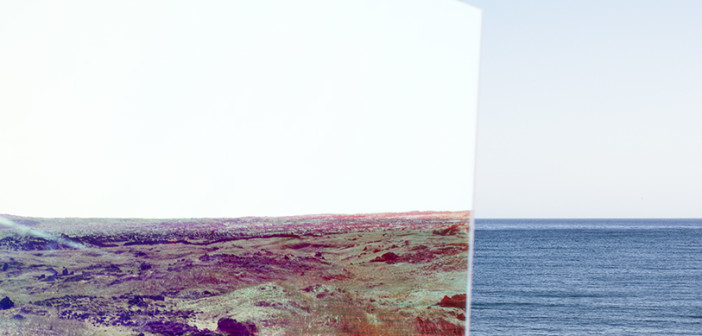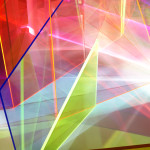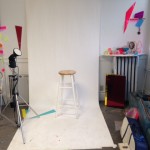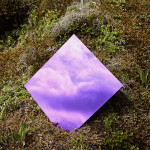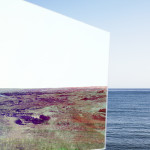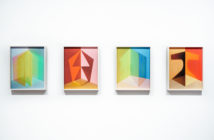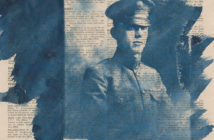I first encountered Bahar Yurukoglu’s work before I knew it was Bahar Yurukoglu’s. I remember walking into Primordial Future, her installation at the deCordova Biennial, because of the way its frozen geometries and shifting lights imposed an atmosphere on me — like suddenly inhabiting a question. My second encounter was with Pink Ice, part of the Green Dream collaboration produced last month by the kijidome group. I was impressed by the way the video spun itself out of a single visual idea, enmeshing the viewer in a web of global implication without ever losing its lightness of touch.
So for my third encounter with Bahar Yurukoglu’s work I went looking for it, and for the artist herself. On the occasion of her new show, Wyoming, at The Hallway Gallery in Jamaica Plain, I went to visit Bahar at her studio and talk to her about her work, past, present, and future.
Now I’m looking down from Bahar’s studio onto the frozen sidewalks of Roslindale Village. Bahar sits on a nearby stool amid the ordered jumble of her workspace, her eyes moving always in a kind of alert, ready survey. A corner unit, the room is modest sized but the light is unmatched. Why pay more, she says, for the same or smaller space in the South End, and no windows? She’d just been turned down at one such place, she remembers, when she was walking by here after work at the thrift shop across the street, saw the For Rent sign, went up, signed the lease.
Things happen like that for Bahar, one downturn quickly followed by a serendipitous uptick — or two or three. But it’s her work that puts her in a position to take advantage of such luck. She was a commercial photographer in New York with a BFA from the School of Visual Arts and a successful line in shooting interiors for glossy magazines. Then the real estate bubble burst and the work dried up. Accepted into the photography program at the Massachusetts College of Art and Design, she soon found herself chafing at the constraints of a 2-D curriculum. "I wasn’t trying to capture a moment any more, the ‘decisive moment’ like in Cartier-Bresson." Instead she wanted to recreate, somehow, the experience of being in that space. The Interrelated Media program offered more of a home for this growing preoccupation.
A period of experiment, of trial and error, followed; Bahar worked with 3D printing, investigated salt as topic and medium. From salt she went to plastic, and that’s when the Eureka moment hit. "I’d been living in New York for so long, and missing nature, and thinking about how we’re taking over the earth." It was all summed up, says Bahar, in plastic — "how it never disappears, how the fumes come out — so I was scared of it." Why not, then, confront that fear head on? She googled "scrap plastic Boston" and found a scrap yard where she bought a shard of pink plexi, put a photograph on it, and mounted it on the wall as an installation. But then something happened: "I thought the projection of the light on the plastic was so much more interesting than the photograph. So I took the photograph away and started playing with the plastic, installing it, photographing it, projecting landscape photographs on top of it. And then I took one of those photographs of the plastic, made a slide and threw it in the carousel, and projected it onto the same piece of plastic. And that came on and that was like, that’s it, that’s the landscape."
Krush
If it was a landscape, it was a landscape of a new type — neoscapes, she calls them. And for Bahar it was simultaneously the discovery of a whole new visual language, entirely abstract. On one of the two drafting tables in her studio she spreads out a sheaf of prints — the Neoscapes series she has been adding to for several years now. They’re just arrangements of colored plastic against a white background, shot a few feet next to where I’m standing. As we sift through the samples, from early to late, I can see a progression: a few sharp shapes brought into contiguity, gradually becoming more and more crisscrossed by reflection and projection until it’s laser tag in a hall of mirrors. New Crack City, Elegy for Place, Diamond Crusted Life — the outside world has been rigorously excluded so that each can propose its own acrylic ecosystem, utopian and dystopian at the same time. But Bahar’s feelings about plastic have evolved along with her work; she’ll confess now to attraction as well as repulsion, acknowledging her own complicity in a spectacle that’s as much Miami Vice as Malevich. "I mean, look at these colors! I’m an 80s kid, after all," she laughs.
But landscapes — the real kind — remain an essential reference point. Regularly Bahar ventures forth with her camera and her bag stuffed with plexi scraps, constructing and photographing temporary, site-specific installations in outdoor settings. But it’s often a specific type of terrain she finds herself looking for. During Spring Break in 2011, while other students were flocking to Fort Lauderdale, Bahar booked a flight to Iceland. If her Neoscapes project an artificial future, the Icelandic landscapes convey a sense of the archaic and elemental: "They’re so unusual, so bizarre; they’re so much like the moon," says Bahar. "And it makes for great light — so much open space. The cool colors, they’re so opposite of the saturated plastics I’m using. I like the meeting of those opposites, the contrasts they create." Later a St. Botolph Club Foundation grant allowed her to take advantage of a residency with the Association of Icelandic Visual Artists in Reykjavik. For the summer solstice she pushed even further north, to Grimsey Island in the Arctic Circle where she photographed the midnight sun for 24 hours.
That led to another crucial moment of synthesis back in Boston, in this room that’s just as much laboratory as studio: "I came back with all this footage of the sun and I built a video — just for myself, a sketch — and from the video I started photographing in the studio by setting up the plexi to mimic the similar pattern of the video — it was a time-lapse video — of the sunlight growing and fading." A translation of the passage of the midnight sun into an arrangement of wall-mounted acrylic, illuminated by a video that is itself translation and distillation of that same solstice light — this would become Bahar’s installation at the deCordova Biennial, Primordial Future, it’s a meditation on, in Bahar’s words, "the rising and falling of things, like societies, and the sun," and for me it’s a summation of all her efforts to date.
But developments in Bahar’s recent work suggest that she’s in no danger of repeating herself. She recently enjoyed a residency with the Brush Creek Foundation for the Arts in Saratoga, Wyoming, and while the landscape shares similarities with her beloved Iceland — she holds up two photographs from those far-flung locales that could be adjacent shots of a panorama — the American West comes with a freight of association that is distinctly its own. Bahar puts it bluntly: "dead animals." Mounted hunting trophies seemed to be staring down over the shelves of every shop. "What do you do with a deer after you hit it with your truck?" she shrugs. "Just leave it there?" So Bahar mounted trophies too, in the installations of her Wyoming show at the Hallway Gallery in Jamaica Plain: skulls, antlers, horseshoes, and glass taxidermists’ eyes now enter into an unsettling dialogue with her characteristic oblongs of plastic. Previously, much of the aura of her work had derived from the organic’s exclusion; even where nature directly appeared in her photographs and temporary outdoor installations, it had been inorganic — sand, rock, ice. The introduction of biomorphic form is a completely new note, one struck even more emphatically in her video Pink Ice, where the animal happens to be live, human, and in fact the artist herself.
That doesn’t mean the Plexiglas is in the rear-view mirror, however. For the month of April, the capacious gallery of the Nesrin Esirtgen Collection in Istanbul will host an exhibition of Bahar’s work that will include a Primordial Future reconfigured for the new site, the Pink Ice video, and a sequence of Iceland and plexi photographs, Melting North. Then she’ll barely have time to catch her breath before her May show of neoscapes opens at the Beth Urdang Gallery in Boston. In the fall, she’ll cross the Atlantic again to set up her contribution to the Lumina Festival in Portugal.
For now, though, Boston remains her base of operations. I ask Bahar if she ever thinks of returning to New York, and she shakes her head. In spite of its drawbacks, this is a place where she can afford to live, work, and have her studio all in the same neighborhood, and what the scene lacks in vibrancy it makes up for in elbow room. "Besides," she smiles, "it’s closer to Iceland."
Wyoming is on view March 1-30, 2014 at The Hallway Gallery in Jamaica Plain.
Primordial Future, part of the 2013 deCordova Biennial, is on view through April 20, 2014 at the deCordova Sculpture Park and Museum.

